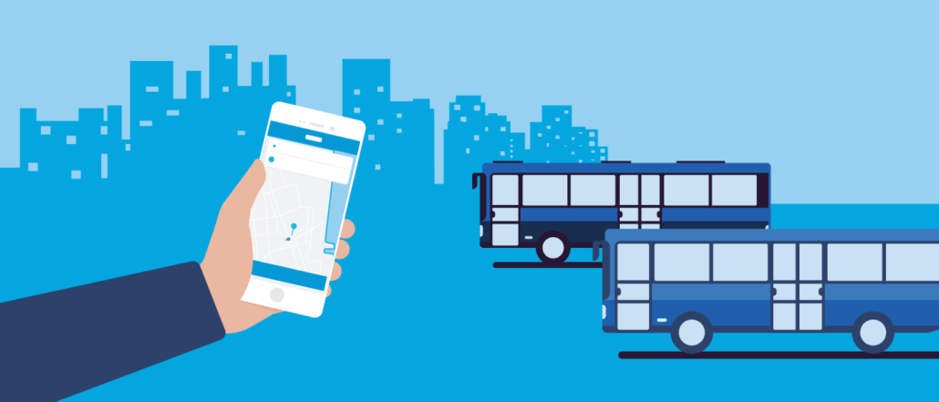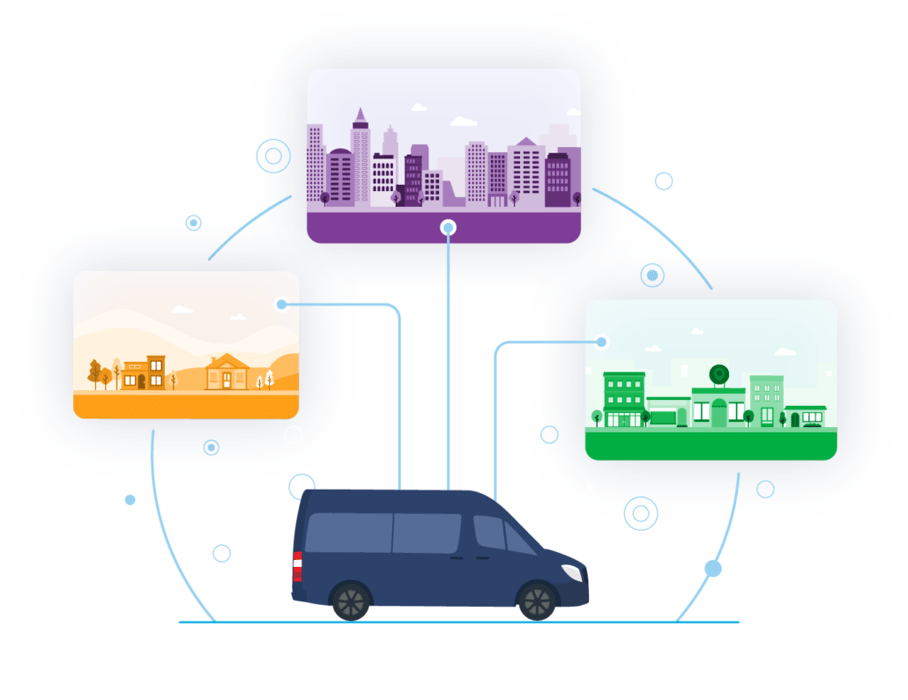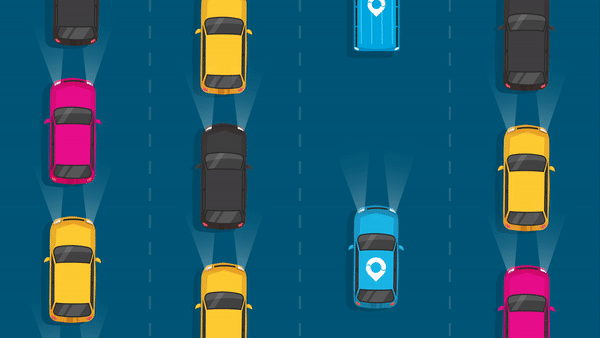Originally published August 13, 2020. Updated July 18, 2024.
Want to skip the long read and get your questions answered now? Jump right into the quick Q&A session, where we address all the key points of this article.
Flexible transit. On-demand transportation. Demand-responsive transit. Mobility on-demand. App-enabled private multi-passenger transportation service. Microtransit. (Macrotransit?)
Sigh. When it comes to microtransit, there’s no need for confusion (life right now is confusing enough). Anyone who runs in transportation circles has probably heard this buzzword in the past few years. Maybe your community already has some sort of microtransit service but known by a different name. And we’d venture to guess anyone who clicks on an article titled “What is microtransit?” is searching for a better explanation, too.
Microtransit is simply tech-enabled shared transportation that lives in the space between traditional fixed route transit and ride hailing technology. Its routes are nimble; its “schedules” aren’t really schedules at all, as they shift constantly based on rider demand; and its vehicles range in size from vans, shuttles, or buses.
Microtransit: A history.
One reason the term "microtransit" gets confusing is because it’s a category that’s seen a warp-speed evolution in the past five or so years, with new players arriving on the scene all the time.
Those dockless e-scooters? Rent-a-mopeds? Bike shares? They’re not exactly microtransit but instead micromobility, a close (and even more micro) relative.
Those old clunky dial-a-ride services? Yep, they’re an early demand-responsive iteration of a larger category we now call microtransit, albeit without any of the technology that makes today’s microtransit efficient and easy to use for riders.
Microtransit is also sometimes difficult to define because it can look very different from city to city — from first-and-last mile rides that make public transit more accessible to operations that feature larger vehicles. “On-demand microtransit could help cities reduce traffic by 15% to 30%.”
— Boston Consulting Group Despite their differences, one thing remains true for all microtransit services: their main goal is to expand a network’s geographic and demographic reach, usually serving populations that are low-density, low-income, and/or lacking other reliable transportation options. While the term microtransit picked up steam around 2015, the use of what some people called “flexible routing” has been around for decades in the United States.
Some early microtransit services relied exclusively on fixed routes — while riders could book a seat on their smartphones, the actual route of the vehicle was fixed much like a traditional bus service — but that model proved unsuccessful time and again. In the developing world, passengers from India to Mexico to the Philippines rely on popular vanpooling networks to move around everyday, everywhere.
Microtransit today.
In contrast to those early services, today’s microtransit means real-time dynamic routing that can change on a moment’s notice, allowing riders to go anywhere in the service zone on-demand. Passengers usually walk a block or two and catch a ride at a “virtual bus stop” — boarding at a common corner avoids unnecessary detours and makes the service much more effective. Along the passenger’s route, sophisticated dynamic routing algorithms use real-time, on-the-ground information to add other people traveling in the same direction into the same vehicle. Riders are picked up and dropped off in an endless stream. This translates into a ride that’s extremely efficient, environmentally friendly, and financially smart.
And the benefits don’t stop there. Modern providers of great microtransit make it a priority to offer full integration with the larger public transportation ecosystem. They offer features like custom-branded (and translated) mobile apps, options to pay with existing fare cards, and multimodal trip planning so riders can get from point A to point B, all in one app. Microtransit is proven to decrease traffic congestion, spur economic development, and reduce the amount of air pollution: we’re talking about a decrease in traffic by 15% to 30% and many tons of carbon emissions, according to Boston Consulting Group. Don’t just take our word for it. The data speaks for itself.

Power anything from a sedan to a city bus.
In 2017, the city of Arlington, Texas, replaced its fixed line bus with on-demand microtransit, providing nearly half its population of 400,000 residents with transportation access that wasn’t there before. In February of 2020, the service expanded again and now impacts more than 89,000 jobs, or about 65% of the city’s total.
Across the globe in Canterbury, New Zealand, Timaru’s MyWay service experienced a technological transformation during COVID-19 when transit leaders implemented on-demand technology across the entire bus fleet and created efficient, on-demand trips for essential workers and services.
It’s safe to say that Arlington and Canterbury are extremely different cities with unique challenges, and replicating what worked in either of these cities isn’t guaranteed to work anywhere else. However, microtransit technology and traditional fixed route transportation are not mutually exclusive, and we’ve found that they very often work well paired together. Take Sevenoaks, a town in the UK that’s pairing technology with existing bus lines to bypass stops where no passengers are waiting. By introducing on-demand technology, they eliminated the need for largely empty buses to circle endlessly, resulting in a 77% increase in service utilization while reducing wait times by 75%. Talk about an immediate impact.
Other towns are getting creative with their own service design to infuse microtransit technology into public transportation. One city in Canada, for example, introduced an on-demand option for riders during off-peak hours, when the regular fixed route bus had limited service and wait times were long. The result: utilization increased, and average wait times went from an hour to just 15 minutes.

Big city or small, microtransit serves them all.
The skeptic in you is probably whispering, “That’s great, but microtransit can’t possibly work everywhere.” Let’s take a look!
- The big city. In New Orleans, Louisiana, for example, you might live in Mid-City and work in the Garden District. Your morning commute could mean transferring to three different bus lines because your home and workplace are not along any single public transportation route. With an on-demand microtransit option, however, you share a shuttle with others to your destination, paying for the trip with the same Jazzy Pass you used on the three bus lines. Along your journey you could pick up a man headed to the supermarket, a co-worker of yours, and a woman on her way to a doctor’s appointment. Your fellow passengers get picked up and dropped off along your same route, making your ride (and his ride, his ride, and her ride) more affordable and efficient.
- The suburbs. Now think about your favorite suburb. A resident wants to visit a friend across town, but she doesn’t have a driver’s license. For another person, microtransit could mean access to a job in the big city that otherwise would be too difficult or time consuming to reach. Taking traditional public transit could mean waiting up to 60 minutes for those infrequent suburban buses (if you even live near a bus stop), but when rides are on-demand, the bus comes to you — and your neighbors — whenever you need it. Need proof? Take a look at Seattle, which allows suburban residents to hail a shared ride to and from five commuter rail stations headed into the city. The service is fully integrated with King County Metro and Sound Transit’s existing network, the trip costs the price of a transfer fee, and passengers can pay using their ORCA Card.
- Rural towns. Often the most lacking in public transportation options, rural areas can offer microtransit as a solution for those who live several towns away from their healthcare facilities, or it can connect non-driving residents or those who don’t own a car to the county’s only shopping mall. Bus networks have always been the linchpin of rural transportation, but they’re inherently challenging to operate efficiently due to lower passenger densities and a car-centric mindset. Microtransit done right is the ultimate solution for rural communities, like in Austin, Texas, where the regional transit authority uses its custom-branded Pickup app in six different rural communities around the city center.

Okay, I get how and where microtransit works. But why do I need it?
Beyond simply moving people efficiently, microtransit has many more positive benefits on society at large and solves for a wide range of real-world problems, including:
- First-and-last mile. In most places, high-frequency transit isn’t within walking distance of where most people live and work. Microtransit connects people to the buses and trains that will then connect them to everything else, while taking single-occupancy cars off the road.
- Transit deserts. It’s not easy to build a transportation network in places that lack the population density necessary for efficient fixed-route buses or trains. Microtransit creates a more convenient and accessible service for riders in these areas.
- Equity and accessibility. Public transit is often a critical lifeline for seniors and people with disabilities. Microtransit optimizes typically inefficient paratransit options, creating real-time bookings, higher quality service, and reducing trip costs with more efficient and equitable shared rides.
- COVID-19 safety. As both supply and demand shift with regulated social distancing measures, transit can respond in real-time. On-demand technology allows fixed routes to morph into dynamic lines, managing peak travel times, pre-booking seats, and accommodating evolving safety practices.
FAQ
What exactly is microtransit?
Microtransit is a tech-enabled, shared transportation service that lives in the space between traditional fixed route transit and ride hailing technology. It uses dynamic routing and scheduling based on real-time rider demand, utilizing vehicles such as vans, shuttles, or buses.
What are the key benefits of microtransit for cities and transit agencies?
Microtransit offers several benefits, including:
- Improved accessibility for low-density and low-income populations.
- Reduced traffic congestion and environmental impact.
- Enhanced integration with existing public transit systems.
- Cost-effectiveness and operational efficiency through real-time, dynamic routing.
Can you provide examples of successful microtransit implementations?
Here are a few examples:
- Arlington, Texas: Replaced fixed-line buses with on-demand microtransit, significantly increasing access to transportation.
- Timaru, New Zealand: Transformed its entire bus fleet to on-demand service during the COVID-19 pandemic, enhancing efficiency and service for essential workers.
- Seattle, Washington: Integrated microtransit with commuter rail stations, improving suburban connectivity.
How does microtransit adapt to different city environments?
Microtransit is highly adaptable and can be tailored to various urban, suburban, and rural settings:
- Urban areas: Reduces the need for multiple transfers and provides efficient, shared rides.
- Suburban areas: Offers on-demand service to and from transit hubs, reducing long wait times.
- Rural areas: Connects residents to essential services and employment, overcoming the challenges of low passenger density.
How does microtransit address first-and-last mile challenges?
Microtransit connects riders to high-frequency transit routes that might be beyond walking distance. By doing so, it removes single-occupancy vehicles from the roads and enhances the overall transit network's reach and efficiency.
How does microtransit improve equity and accessibility?
Microtransit provides critical transportation for seniors and people with disabilities by optimizing paratransit options. It offers real-time bookings, higher quality service, and shared rides that are more efficient and cost-effective.
How well does microtransit integrate with existing public transportation systems?
Microtransit can fully integrate with larger public transportation ecosystems, offering features like custom-branded mobile apps, multimodal trip planning, and the ability to pay using existing fare cards. This integration simplifies the travel experience for users and enhances overall network efficiency.
What are the environmental benefits of microtransit?
Microtransit helps reduce traffic congestion and lower carbon emissions. By using dynamic routing and shared rides, it cuts down on the number of single-occupancy vehicles on the road, leading to significant environmental benefits.
Why should transit agencies consider implementing microtransit?
Microtransit is a transformative solution that expands transportation access, reduces operational costs, and integrates seamlessly with existing transit systems. It offers a flexible, efficient, and environmentally friendly alternative to traditional transit models, making it an ideal choice for modern urban mobility challenges.
How can we start a microtransit service with Via?
Contact Via to discuss your city's specific needs and explore tailored microtransit solutions. Our experts will guide you through the implementation process, ensuring a service that meets your community's unique requirements. Let's chat and transform your city's transportation today!




